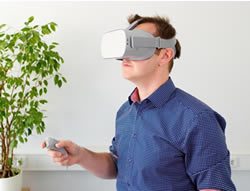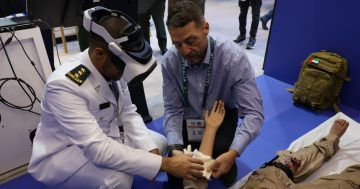Katie Andrews* reports on a new study that found VR could improve health and safety training at work — without putting anyone at risk.

Photo: D. Lohner
A new study suggests employee safety could be improved through use of Virtual Reality (VR) in Health and Safety training such as fire evacuation drills.
The Human Factors Research Group at the University of Nottingham developed an immersive VR system to stimulate participants’ perception of temperature, and senses of smell, sight and hearing to explore how they behaved during two health and safety training scenarios: an emergency evacuation in the event of a fire and a fuel leak.
In one scenario, participants had to evacuate from a virtual fire in an office, seeing and hearing using a VR headset but could also feel heat from three 2 kW heaters, and could smell smoke from a scent diffuser, creating a multisensory virtual environment.
This group was compared against another group who were observed in this scenario using only audiovisual elements of VR.
Previous research on human behaviour during real-world fire incidents has shown that a lack of understanding of the spread and movement of fire often means that occupants are unprepared and misjudge appropriate actions.
Immersive health and safety training enables employers to train people about hazards and hazardous environments without putting anyone at risk.
The Nottingham research, funded by the Institution of Occupational Safety and Health (IOSH), found contrasts between the groups in the way participants reacted to the scenario.
Those in the multi-sensory group had a greater sense of urgency, reflecting a real-life scenario, and were more likely to avoid the virtual fires.
Evidence from the audiovisual participants suggested that they were treating the experience more like a game and behaviours were less consistent with those expected in a real-world situation.
“Health and safety training can fail to motivate and engage employees and can lack relevance to real-life contexts,” said study lead Dr Glyn Lawson, Associate Professor in the Faculty of Engineering at the University of Nottingham.
“Our research … suggests that virtual environments can help address these issues, by increasing trainees’ engagement and willingness to participate in further training.”
“There are also business benefits associated with the use of virtual environment training, such as the ability to deliver training at or near the workplace and at a time that is convenient to the employee.”
Virtual reality vs PowerPoint
A further test was done, as part of the study, to measure the effectiveness of VR training versus traditional PowerPoint training.
Participants took questionnaires, testing their knowledge on either fire safety or safe vehicle disassembly procedure, before and after training as well as one week later.
While those trained via PowerPoint appeared to have gained more knowledge when tested directly after training, there was a significantly larger decrease in knowledge scores when participants were retested one week later.
In comparison, the VR group’s long-term retention was better and reported higher levels of engagement, attitude to occupational safety and health, and willingness to undertake training in the future.
The research suggests that the increased cognitive engagement of learning in the virtual environment creates more established and comprehensive mental models that can improve recall, and implies that testing an employee’s knowledge immediately following health and safety training may not be an effective means of gauging long-term knowledge of health and safety.
Applications to the workplace
“The wheels are turning so that virtual and smart learning is increasingly ingrained in the workplace and everyday life,” said Mary Ogungbeje, Research Manager at IOSH.
“Technology is continuously advancing and in many cases becoming more affordable, so this study gives us a taste of what’s to come.”
“By improving training strategies with the use of technology and stimulated sensory experiences, we are heading in a direction where the workforce will not just enjoy a more immersive and interesting training course but participate in an effective learning experience, so they are better prepared and equipped to stay safe, healthy and well at work.”
The researchers conducted meetings, discussions, and visits with partners including Rolls-Royce, for expert advice around fire safety and safe handling of hazardous chemicals.
The University of Nottingham’s Health and Safety advisors also contributed to help the researchers better understand how the training may be implemented in industry.
The study aims to produce evidence-based guidance for the development and use of virtual environments in engaging and effective training using cost-effective and accessible solutions.
* Katie Andrews is Media Relations Manager Engineering in the Press Office at the University of Nottingham.
This article first appeared at www.nottingham.ac.uk.











